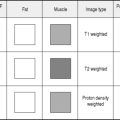Chapter 15 Lacrimal system and salivary glands
Digital Subtraction and CT Dacryocystography
Dacryocystography allows visualization of the lacrimal system by direct injection of contrast into the cannalicus of the eyelid. It may be combined with CT imaging performed immediately after lacrimal system contrast injection. CT imaging gives additional diagnostic information, particularly about adjacent structures.1
Technique
MRI of Lacrimal System
The lacrimal system can be assessed with MRI (MR dacryocystography) either following topical administration of eye drops containing a dilute gadolinium solution (sterile 0.9% NaCl solution containing 1:100 diluted gadolinium chelate) or by direct injection of a dilute gadolinium solution into the lacrimal canaliculus.1 The less invasive, topical administration technique is more widely used. MR is useful in the diagnosis of obstruction level in the lacrimal system for patients with epiphora and in assessment of surrounding soft tissues.
Methods of imaging the salivary glands
Bialek E.J., Jakubowski W., Zajkowski P., et al. US of the major salivary glands: anatomy and spatial relatinships, pathological conditions and pitfalls. Radiographics. 2006;26(3):745-763.
Freling N.J. Imaging of salivary gland disease. Semin. Roentgenol.. 2000;35(1):12-20.
Rabinov J.D. Imaging of salivary gland pathology. Radiol. Clin. North Am.. 2000;38(5):1047-1057.
Yousem D.M., Kraut M.A., Chalian A.A. Major salivary gland imaging. Radiology. 2000;216(1):19-29.
Conventional and CT Sialography
Technique
ULTRASOUND AND MRI OF SALIVARY GLANDS
MR is very useful in the diagnosis of lesions of the salivary glands.
A heavily T2-weighted sequence can image the ductal system of the major salivary glands in the diagnosis of sialolithiasis and sialadenitis (MR sialography). Non-contrast studies can be useful in differentiating benign or low-grade malignant from high-grade malignant tumours. Contrast enhancement is useful in the differential diagnosis of cystic from solid lesions, and when determining the degree of perineural spread of malignant disease.1 Diffusion weighted imaging and MR spectroscopy are increasingly used for the characterization of salivary gland masses.2





